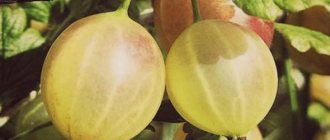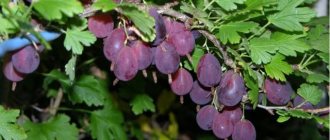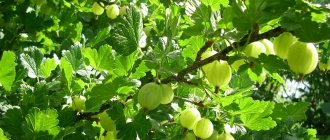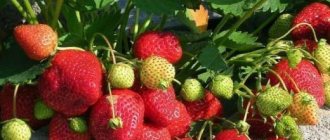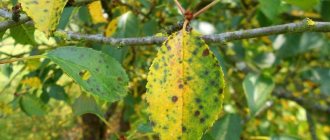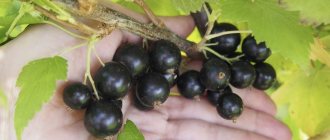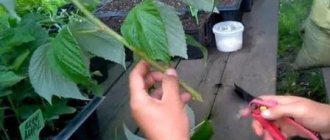Characteristics, description
The gooseberry bush of this high-yielding variety reaches a height of about 1.5 m. It has a slightly spreading appearance. The shoots are gray with a purple tint and grow straight; there are single thorns, often located throughout the shoot.
The leaves are dark green with a blunt-toothed edge, leathery, and medium in size.
Important! English yellow gooseberries are not planted near groundwater, because they do not tolerate waterlogged soil.
Fruiting begins 3–4 years after planting , with peak harvesting occurring in the second half of July. From 1 bush you can collect from 8 to 12 kg of fruit. The berries with translucent veins have a beautiful amber color and are shiny.
The average weight of one fruit is 3–4 g, but specimens up to 8 g can be collected. The berries have a dense, glossy skin with few hairs. The aroma of the berries is almost imperceptible, the taste is sweet with a subtle sourness.
General information about the English Yellow variety
Shrub 1.5 meters high, slightly spreading. The English gooseberry variety has a high degree of resistance to low temperatures. The origin of this variety is unknown, but breeders note the yield and taste of the fruit.
The berries have the following description: medium density, yellow flesh, do not crumble after ripening. The average weight of the berry is 5 grams, however, with high yields, the weight of the gooseberry can be up to 7 grams.
Gooseberry shoots are covered with single thorns, the leaves are small and dark green in color. The inflorescences are white, with brown sepals.
Advantages and disadvantages
Speaking about the positive and negative qualities of English yellow gooseberries, a lot depends on personal taste needs, on the ability to care for the plant and on the climate in which this crop will grow.
- The advantages include:
- straight growth of the bush, which makes harvesting easier;
- high productivity;
- good taste;
- beautiful unusual color of the fruit;
- high winter hardiness;
- good resistance to transportation;
- resistance to pests and diseases.
There are also disadvantages that gardeners cite.
- These include:
- unsuitable for freezing, the berries lose their taste;
- lack of aroma;
- low resistance to sphere library;
- the presence of a large number of thorns, which interferes with harvesting;
- the possibility of fruit cracking due to high humidity - crop loss during prolonged rainy weather can reach up to 50%.
Familiarize yourself with the growing features and properties of gooseberries.
Drought resistance, frost resistance
The variety is unpretentious to watering and tolerates dry periods well. Excess moisture negatively affects the fruits - they crack.
Tolerates winter well. Without shelter it can withstand frost down to –20°C. In regions where winters have little snow and the cold period lasts a long time, it is better to use shelters. With prolonged cold autumn rain, young shoots may freeze.
Productivity and fruiting
According to descriptions and reviews of experienced gardeners, English yellow gooseberries provide excellent and stable yields. By following the rules of plant care, you can get up to 15 tons of berries from 1 hectare.
The main period of fruit ripening falls from July 12 to July 25. This time period may vary slightly in different regions.
Description of the Baltic gooseberry variety
Baltic gooseberries are rightfully called one of the best varieties for the North-West region. The plant produces high yields, is resistant to diseases, adverse weather conditions and is easy to care for.
History of origin and distribution
The breeding of the variety was carried out by scientists Alekseeva N. M. and Studentskaya I. S. at the Leningrad fruit and vegetable experimental station in 1947. By crossing Mysovsky 17 and Industry, breeders have developed a new berry bush that is promising for risk farming. The Baltic gooseberry has not become widespread among amateur gardeners, but scientists predict a great future for the culture.
Landings
Gooseberry bushes grow well next to their close relative, currants, because they have similar care conditions.
Important! The place for planting gooseberries should be protected from strong winds and drafts.
Deadlines
Plant seedlings are planted mainly in the last ten days of March, during the snow melting period. Less often, seedlings are rooted in the fall. This should be the period before the onset of the first frost.
Choosing a suitable location
The plant loves sunlight, so you should choose a place for planting where, after 12 noon, the bushes will receive the bulk of the sun's rays.
Selection and preparation of planting material
For full development, the plant needs trace elements and magnesium. It is also recommended to apply potassium fertilizer, so before planting, not only dig up the soil, but also fertilize it a month or two before planting.
Rotted manure and wood ash are used as fertilizer. Additionally, sand is added to the soil - it softens it and makes it permeable.
Each hole should be filled almost half with the mixture: fertile soil (3 parts), fertilizer (2 parts), sand (1 part). Annual or biennial plants are planted in open loamy soil with a neutral pH. It is better to buy them in specialized stores or from reliable suppliers.
Important aspects when purchasing seedlings:
- Each seedling should have 1–2 shoots, each 30–50 cm long.
- The bark on the plant should be uniform and not cracking.
- The roots should be strong, without rotten areas, not dry, and from 12 to 17 cm long.
Find out more about when gooseberries begin to bear fruit after planting seedlings.
Planting scheme
If the soil is too acidic, a little lime can be added before mulching. Every step when planting matters , nothing can be missed, then the plant will take root well and in the future will produce a decent harvest.
- When planting several seedlings, the distance between them should be maintained at 1–1.5 m.
- The holes for planting should be 40x50x40 cm. You can add 1 tbsp to each hole. l. complex mineral fertilizer mixed with soil.
- At the bottom of the hole you need to form a “pillow” of soil.
- In a vertical position, the seedling is placed in the hole and the roots are straightened. The root collar is not deepened more than 7 cm.
- The seedling is covered with soil in small portions, constantly compacting and watering it. There should be no air gaps left in the soil. For 1 bush of water you will need about 10 liters of water.
- Each bush is mulched with garden compost or well-rotted manure to retain moisture. This will simultaneously feed the plant.
- The shoots on the bush need to be trimmed, leaving 5-6 buds on each.
Growing and care
For the rapid development of a seedling into a full-fledged bush, an integrated approach is necessary - all agrotechnical techniques should be carried out in a timely manner, water should be given in the right quantity.
Attention! Mulching the space under the bush with a layer of organic matter - compost, humus or chopped straw - will help to significantly reduce the time required to perform labor-intensive operations of loosening and watering.
In comparison with other garden crops, gooseberries easily tolerate the “dry” regime. The need for watering arises only in the absence of rain during the most critical periods of bush development:
| Development phase | Deadlines for the Central region |
| Bloom | 2nd half of May - 1st ten days of June |
| Fruit formation | 2nd half of June |
| Moisture-charging autumn watering | 2nd half of September - 1st half of October |
Watering rule : around the bush, at a distance of 40 cm from the projection of the crown, a groove with a depth of 10...15 cm is formed along the perimeter. Water is poured only into the groove - it is contraindicated to wet the bush. 1 bush requires up to 3 buckets of water. This volume will be enough to wet the soil to a depth of 40 cm.
Watering bushes is often combined with fertilizing. While the gooseberry does not bear fruit, it has enough food reserves from the planting hole, and starting from the 3rd year of life, the abundantly fruiting bush needs additional nutrition.
| Top dressing | Period | Method of application and proportions |
| Nitrogen spring | Before the buds open | 25-30 g of urea per bush before loosening |
| Comprehensive | After flowering | For 10 l. water – superphosphate (3 tbsp.), potassium chloride (2 tbsp.), urea (1 tbsp.) |
| Autumn | After leaf fall | 4 kg. humus, 2 tbsp. superphosphate. 1 tbsp. potassium sulfate |
Features of seasonal care
Every young plant needs proper care, which includes watering, loosening the soil, removing weeds, pruning, preventive procedures and fertilizing.
Important! Stimulants
“
Kornevin
”
or
“
Flora-S
”
can help the plant take root, so treatment with these drugs will benefit the gooseberry.
Soil care
After planting, it is important to maintain constant soil moisture. If you do not water the plant for a long time, and then water it abundantly after a dry period, the fruits will swell and split too quickly.
After flowering, the soil must be mulched again and watered with a superphosphate solution in proportions of 40–60 g per 1 m² of tree trunk circle. This procedure will improve the quality of the crop.
Loosening the soil should be carried out in a timely manner, approximately 5 times per season. As weeds appear, they need to be removed and prevented from pests.
Preventative treatment
Shrubs are sprayed with wood ash until flowering. It will serve as a useful source of potassium, which will help plants bloom, bear fruit and prevent powdery mildew.
Spraying solution: add 450 g of ash to 1 bucket of hot water (10 l) and leave to steep for 48 hours.
Soap solution for spraying: dissolve 50 g of soap in a 10-liter bucket of hot water, add 1.3 kg of ash. Leave to infuse for two days.
Feeding
Spring feeding is mandatory for successful fruit set and ripening. In the fall they are needed to prepare for wintering.
The soil should be regularly mulched with thin layers of dry grass to supply nitrogen and potassium. This will serve as a kind of organic feeding.
A little nitrogen applied to the surface of the soil will not harm English yellow gooseberries. The proportions must be kept exact, otherwise problems with mold and aphids may arise. For 1 bush you need 20 g of ammonium nitrate and urea and 40 g of calcium nitrate.
If yellowing of the leaves is observed in the first year of planting, then the bushes can be fed with the following solution: add 15 g of ammonium nitrate to 1 bucket of water (10 l). Spend 5 liters for each bush.
For foliar feeding at the end of May or early June, use a solution of potassium sulfate and superphosphate (1–2%), as well as a solution rich in microelements: take a 0.1% solution of manganese sulfate and a 0.01% solution of boric acid.
In the fall, after the leaves fall, the soil is dug up and 3–4 kg of rotted manure is applied under each bush.
Support
Sunlight should reach the gooseberry branches as much as possible.
So, a bush holder, bought in a store or made by yourself, will be an excellent solution for ensuring that the shoots have the correct location in relation to the sun. In addition, it will become more convenient to cultivate the land around the bush.
Find out the main types of fencing for gooseberries and how to make them yourself.
Supports can be:
- special devices sold in stores;
- wooden pegs driven into the ground around the bush with wire, string or twine attached in a circle;
- spears driven around gooseberry bushes, with even branches of fruit trees placed on top;
- scraps of metal pipes instead of pegs.
Trimming
For pruning, you will need a well-sharpened pruner to get a clean cut and speed up the healing process of the plant. Fruit bushes are pruned when they are dormant - in October and March. In the case of English yellow gooseberries, this is best done before the buds begin to open.
The ideal shape of a trimmed gooseberry bush is a glass with an open center. Evenly spaced branches should be directed away from the middle of the bush and not adjacent to each other so that there is access to sunlight.
One-year-old branches do not produce fruit, and with an age of more than 3 years their productivity decreases. The best fruits in terms of quantity and taste are produced in the 2nd and 3rd years after planting. All branches older than 4 years must be cut out. Large and old branches that crowd the center of the bush are removed completely. This will ensure good ventilation, reduce the likelihood of mold and make harvesting much easier. Single shoots growing around the main stem are also removed.
With annual pruning, approximately 1/3 of the total number of shoots is removed. Pruning branches between buds or side shoots will lead to vigorous growth of small growths, and this will have a negative impact on the plant. The shoots will begin to grow too thick, blocking sunlight. To get larger fruits, you need to reduce the side shoots to 2 buds from the beginning of last year's growth.
Did you know? Gooseberry fruits are often green with light stripes, but there are varieties in which the color of the fruit can be red, yellow, purple, white and even black.
Rules for caring for English gooseberries
An adult bush, like a seedling, requires a certain type of care. Timely application of fertilizers and watering of the crop will contribute to the development of shrubs and the annual harvest.
Watering and fertilizing
The gooseberry variety tolerates moderate drought, the English yellow variety is susceptible to root diseases in the presence of excessive moisture. Watering the crop is carried out in several stages, among which it is necessary to highlight:
- the first is carried out on the 20th of May;
- the second watering is carried out a month later;
- the third is after the harvest.
In dry weather, the shrub needs to be watered every three weeks. Watering is carried out in the following way:
- measure a distance of 60-70 cm from the root of the bush;
- make a ditch 10 cm deep around the bush;
- water is poured into the ditch.
Up to 30 liters of water must be used per adult plant.
Fertilizers are applied to the soil according to the following scheme.
| Feeding period | Fertilizer type |
| First days of April | Boil 1 kg of potato peelings in 10 liters of water. Leave to room temperature, add 200 grams of ash. Mix everything thoroughly and pour into the root area of the bush. |
| After the color falls | Mix 200 grams of urea, 400 grams of superphosphate and 100 grams of potassium in 5 liters of water. A bucket of clean water is poured into the ditch, with the resulting solution on top |
| During fruit formation | Bird droppings are used in the proportion of 1 kg per 10 liters of water |
| After harvest | 2 buckets of humus are brought under the bush and watered generously |
It is recommended to apply fertilizer in the evening after sunset.
Trimming
In the second year after planting, it is necessary to leave 2-3 strong shoots. Every year it is necessary to form a bush, while old branches are removed and young shoots are left in place.
See also
The best way to feed gooseberries, how to water them properly in summer and autumnRead
Pruning is carried out in spring and autumn; all damaged and small shoots must be eliminated. Branches that are intertwined in a large number of places are also removed. In order for the bush not to outgrow fruiting, it is necessary to shorten the shoots by one third annually.
Sheltering shrubs for the winter
After the leaves fall, it is necessary to prepare the shrub for the winter:
- clear the soil around the crop from leaves, dig it up and add humus;
- collect the branches of the bush and tie them with a strip of fabric;
- treat the branches with a solution of Bordeaux mixture (1%);
- Wrap the branches with burlap.
Digging the soil is necessary to eliminate pests that may be hiding in fallen leaves and branches.
Harvesting and storage
English yellow gooseberries are harvested in several stages, starting in the second half of July. During the period of technical maturity, the fruits are used to make jam, because they have good density.
For tasting and fresh consumption, yellow varieties are best used when they have received the richest color and are fully ripe.
Harvest storage:
- ripe fruits are stored well for about 5 days at +2°C;
- To preserve the harvest longer or prepare it for transportation, the fruits must be collected a week before full ripening. Such a crop can be stored in a room with high humidity at 0°C for 30 days;
- If storage conditions with high humidity and a temperature of –2°C are created for the fruits, the storage period of the crop can increase to 3 months without loss of presentation.
According to gardeners, the variety not only has an excellent presentation and taste, but also a long shelf life and good transportability.
Advantages and disadvantages of the variety
Among the disadvantages of English yellow gooseberries, gardeners note the presence of thorns, cracking of the skin of the berries when there is excess moisture, and insufficient resistance to some fungal diseases.
Culture has many more advantages. The positive characteristics of English Yellow include:
- marketable appearance of fruits that meets consumer demand;
- high productivity;
- adaptability to growing conditions;
- winter hardiness down to -26°C, drought resistance;
- preservation of the original appearance during long-term transportation;
- dessert sweet and sour taste of berries.
The compactness of the bushes, which facilitates agricultural technology, high immunity, attractive appearance and taste of the fruits make gooseberries attractive not only for personal use, but for growing for commercial purposes.
Preparing for winter
Before wintering, the soil around the bushes is loosened, weeds and fallen leaves are removed, and the plant is treated with 1% Bordeaux mixture. Then the shoots are tied into a bundle with twine and tilted towards the ground.
Despite the winter hardiness of the English yellow gooseberry variety, during light snow and long cold winters the bushes are covered with spruce branches, burlap and other covering material, reinforced with boards on top.
Gooseberry bushes bent to the ground are covered with dry leaves
Reproduction methods
Several options are suitable for propagating English yellow gooseberries:
- Cuttings . You will need mature shoots, the bark of which will be completely woody. A large number of seedlings can be obtained by dividing and germinating parts of the plant.
- Reproduction by layering . Horizontal layerings that are at least 3 years old are suitable.
- Dividing the bush into 2–3 parts. Manipulations are carried out in autumn or early spring.
Reviews
I planted “English Yellow” primarily because of the yellow color of the fruits. I also have red gooseberries, I decided to diversify the garden a little. What I like. The branches are straight-growing, directed upward, the bush takes up little space, it is convenient to loosen the soil under it, water it, etc. The berries are sweet, good for fresh consumption and preparations. My husband makes wine from this gooseberry; it turns out a very beautiful and tasty golden-yellow drink. The yield is high, 20 kg each, as they assured me at the nursery, but I consistently collect a little more than a five-liter bucket. What I don't like. There are thorns and they are along the entire length of the branches, and not just in the lower part, as in many other varieties. The berries burst in rainy weather. As for planting, my soil is clayey, I added a bucket of coarse sand to each hole, to increase fertility – a bucket of humus, a few spoons of Nitrophoska, a cut glass of ash and “Berry” fertilizer.
I have been growing English yellow for over 10 years. I'll tell you about my observations about the variety. 1) Be sure to loosen the gooseberries 5-7 times per season. Air exchange increases, the bush develops faster and productivity increases. 2) Weed. Weeding is needed not only to prevent weeds from “pulling” nutrients from the soil. A large number of weeds increases the humidity in the lower part of the bush, increasing the risk of powdery mildew. 3) In addition to fertilizing in the ground, use foliar application of fertilizers. For example, in May I spray the bushes with the following solution: 1 tbsp. spoon of urea + 3 gr. potassium permanganate per 10 l. water. I fertilize 2 times at intervals of a week. 4) Be sure to prune. Branches older than 5-7 years do not bear fruit and must be cut out. The bush should consist of about 20 branches of different ages, about 5 each, from the first to the fourth year. 5) Don't forget about watering in the fall. Moisture-recharging irrigation is necessary because... the plant will overwinter better and the roots will not freeze in wet soil. 6) Spraying against diseases and pests is not mandatory, but prevention has never hurt anyone. If you are afraid of chemicals, then you should at least pour boiling water on the bushes in early spring from a watering can. If you are not afraid of drugs, then the simplest thing is to spray the gooseberries with a 1% solution of Bordeaux mixture. 7) Any fertilizer can be used, but the main thing is to follow the rule: in the spring, nitrogen-containing ones, for example, urea, in the summer and autumn - superphosphate and potassium sulfate. If you give nitrogenous fertilizers in the fall, you will provoke the growth of the bush and it will be poorly prepared for winter.
English yellow is an old, proven variety that does not cause any particular difficulties in growing. Pruning, fertilizing, watering - nothing supernatural is required to remove up to 2 buckets of sweet amber-colored berries from each bush every year.
Gooseberries are a berry that is popular among summer residents; the English yellow variety attracts with its taste and ease of care. The berries are suitable for storage and contain all the necessary vitamins. Used for preservation for the winter and for fresh consumption.
Diseases and pests
Gooseberries have main enemies that can affect fruiting: birds, gooseberry mold (a rare occurrence for this variety), hungry sawfly larvae, spider mites, aphids and moths.
It will also be useful for you to learn how to deal with lichen and moss on gooseberries.
Birds not only steal the fruits, but also peck the buds. To scare away birds, nets, rustling strips of foil and other homemade devices are used.
Mold on shrubs may appear as a powdery grayish-white fungus on the leaves and stems or as a felt-like coating on the fruit. The coating is initially white and then turns pale brown.
Poor air circulation contributes to the development of this disease. Gooseberry sawfly larvae are pale green and look like caterpillars. In the short time between mid-spring and harvest, they can completely destroy bushes. You need to check the underside of the leaves and remove any sawfly larvae.
Shoot aphids feed on the sap of leaves, which causes them to fall off.
Having noticed the larvae on the leaves, you need to treat the plant with the following means: “Karbofos”, “Aktellik”.
Did you know? There are varieties of gooseberries that are grown in the Arctic Circle.
Spider mites , like aphids, feed on leaf sap. They develop marbled spotting. The best time for prevention is before the buds open.
Firefly is a butterfly ; its caterpillar feeds on the juicy pulp of the fruit. For prevention, they are treated with Karbofos after flowering.
When thinking about whether or not to plant English yellow gooseberries on your plot, the answer is obvious - it’s worth a try. You can find many more advantages for yourself than disadvantages.
General information about the English Yellow variety
Shrub 1.5 meters high, slightly spreading. The English gooseberry variety has a high degree of resistance to low temperatures. The origin of this variety is unknown, but breeders note the yield and taste of the fruit.
The berries have the following description: medium density, yellow flesh, do not crumble after ripening. The average weight of the berry is 5 grams, however, with high yields, the weight of the gooseberry can be up to 7 grams.
Gooseberry shoots are covered with single thorns, the leaves are small and dark green in color. The inflorescences are white, with brown sepals.

